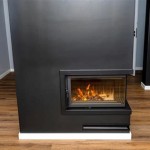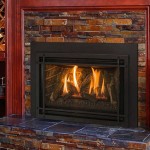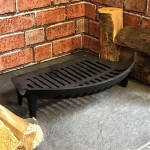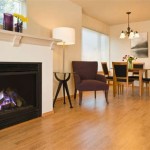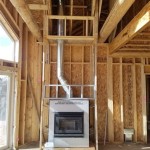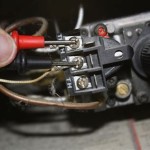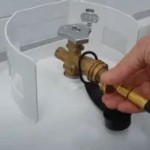Replacing a Wood-Burning Fireplace with a Gas Insert: A Comprehensive Guide
The allure of a crackling wood-burning fireplace is timeless. However, the reality of wood-burning can be less idyllic, involving the sourcing, storing, and handling of firewood, the mess of ash and soot, and the environmental impact of smoke emissions. Replacing a wood-burning fireplace with a gas insert provides a convenient, cleaner, and often more efficient alternative. This article explores the process of replacing a wood-burning fireplace with a gas insert, covering the key considerations, benefits, steps, and potential challenges involved.
A gas insert is a self-contained unit that fits directly into an existing wood-burning fireplace opening. It operates on natural gas or propane and offers a controlled flame with adjustable heat output. Modern gas inserts prioritize aesthetics, replicating the look of a traditional wood fire with realistic ceramic logs and glowing embers. This makes them a desirable option for homeowners seeking the ambiance of a fireplace without the associated drawbacks.
Benefits of Converting to a Gas Insert
Switching from a wood-burning fireplace to a gas insert offers several advantages. Understanding these benefits is crucial when deciding whether this renovation is right for a specific home and lifestyle.
Convenience: Gas inserts are incredibly convenient to operate. Starting a fire is as simple as flipping a switch or pressing a button on a remote control. Users can also easily adjust the flame height and heat output to their desired level of comfort. No more hauling wood, building a fire, or waiting for it to heat up. This eliminates the physical labor and time commitment associated with wood-burning fireplaces.
Cleanliness: Unlike wood-burning fireplaces, gas inserts produce minimal ash, soot, or creosote. This significantly reduces the amount of cleaning required and lowers the risk of chimney fires. The reduced mess also contributes to a cleaner and healthier indoor environment.
Efficiency: Gas inserts are generally more energy-efficient than wood-burning fireplaces. Many models boast efficiency ratings of 70% or higher, meaning a larger portion of the energy produced is used to heat the room. This can translate to lower heating bills, especially when used as a supplemental heat source.
Environmental Friendliness: Gas inserts burn cleaner than wood-burning fireplaces, producing fewer emissions and contributing less to air pollution. While gas combustion does release carbon dioxide, the overall environmental impact is typically less than that of burning wood, particularly when considering the unsustainable harvesting practices in some regions.
Safety: Modern gas inserts are equipped with safety features such as automatic shut-off valves and oxygen depletion sensors. These features help prevent gas leaks and carbon monoxide poisoning, making them a safer option than traditional wood-burning fireplaces, especially when properly installed and maintained.
Key Considerations Before Installation
Before embarking on the installation process, several factors must be carefully considered to ensure a successful and safe conversion. These include assessing the existing fireplace, choosing the right gas insert model, and understanding the necessary gas line requirements.
Fireplace Assessment: The first step is to thoroughly inspect the existing fireplace and chimney. A qualified professional should assess the chimney’s structural integrity, including any cracks or damage that could compromise its safety. The firebox dimensions also need to be measured accurately to ensure the chosen gas insert will fit properly. Minor modifications to the firebox opening may be necessary in some cases.
Gas Line Requirements: A gas line is essential for operating a gas insert. If there isn't an existing gas line near the fireplace, one will need to be installed by a licensed gas fitter. This process involves running a gas line from the main gas supply to the fireplace location, adhering to all relevant safety codes and regulations. The gas fitter will also determine the appropriate gas line size and pressure requirements for the specific gas insert model.
Ventilation System: Gas inserts require proper ventilation to safely exhaust combustion byproducts. Most gas inserts are either direct-vent or B-vent models. Direct-vent inserts draw air from outside for combustion and vent exhaust gases directly outside through a sealed system. B-vent inserts use the existing chimney to vent exhaust gases. The choice of ventilation system depends on the existing chimney’s condition and local building codes. A professional installer can help determine the most appropriate and safe ventilation solution.
Gas Insert Selection: Selecting the right gas insert model involves considering factors such as heating capacity, aesthetics, and features. Heating capacity is measured in British Thermal Units (BTUs). The appropriate BTU rating depends on the size of the room the fireplace is intended to heat. Aesthetics play a significant role, with various styles of log sets, firebox liners, and decorative fronts available. Additional features may include remote controls, thermostats, and blowers to circulate heat more effectively.
Permits and Regulations: Before starting the installation, it is essential to obtain the necessary permits from the local building department. Gas line installation and fireplace modifications are typically subject to strict building codes and regulations. Failing to obtain the required permits can result in fines and delays.
The Installation Process: A Step-by-Step Guide
Replacing a wood-burning fireplace with a gas insert typically involves several key steps. While some homeowners may attempt a DIY installation, it is highly recommended to hire a qualified and licensed professional to ensure safety and compliance with building codes.
Preparation: The first step is to prepare the fireplace opening. This involves cleaning out any remaining ash or debris from the wood-burning fireplace and removing any existing grates, screens, or other accessories. The chimney should also be cleaned and inspected by a professional to ensure it is free of obstructions and in good condition.
Gas Line Installation: If a gas line is not already present, a licensed gas fitter will install one to the fireplace location. This involves running the gas line from the main gas supply, connecting it to a shut-off valve near the fireplace, and pressure testing the line to ensure there are no leaks.
Insert Placement: Once the gas line is in place, the gas insert can be carefully positioned into the fireplace opening. The insert should be centered and level. Some models may require additional support or bracing to ensure they are securely mounted.
Ventilation Connection: The ventilation system, whether direct-vent or B-vent, must be properly connected to the gas insert and the chimney or vent termination. This involves attaching the vent pipes to the insert and ensuring they are securely sealed to prevent exhaust gases from leaking into the room. Direct-vent systems require a special vent termination kit that extends through an exterior wall.
Gas Connection: A licensed gas fitter will connect the gas line to the gas insert, ensuring all connections are tight and leak-free. The gas supply should be turned on slowly, and all connections should be checked for leaks using a gas leak detector.
Testing and Calibration: After the gas line is connected, the gas insert should be tested to ensure it is operating correctly. This involves starting the fire, adjusting the flame height, and verifying that the ventilation system is functioning properly. The gas insert may also need to be calibrated to ensure it is burning efficiently and safely.
Finishing Touches: Finally, the finishing touches can be added to enhance the aesthetics of the gas insert. This may include installing a decorative front or surround, adding a log set, and arranging the embers to create a realistic fire appearance. The area around the fireplace should be cleaned up, and any remaining materials should be disposed of properly.
Final Inspection: After the installation is complete, it is essential to have the work inspected by a qualified building inspector to ensure it complies with local building codes and regulations. This inspection will help identify any potential safety issues and ensure the gas insert is operating safely and efficiently.
Potential Challenges: While converting a wood-burning fireplace to a gas insert offers numerous benefits, there are also potential challenges that homeowners may encounter. These challenges include unexpected structural issues, gas line complications, and ventilation problems. Addressing these challenges often requires the expertise of a qualified professional.

Convert From Wood To Gas With A Insert The Kernel Burner

Convert To Gas Installing Fireplace Inserts Doctor Flue

Can A Wood Burning Fireplace Be Converted To Gas The Flame Company

Converting A Wood Burning Fireplace And Installing Gas

Fireplace Inserts Explained Typical Sizing Functionality More

Fireplace Insert Guide Fireplaces Direct Learning Center

How To Convert Your Wood Burning Fireplace Electric Or Gas

Fireplace Insert Installation Wood Inserts Gas Pellet And Electric

Convert A Wood Fireplace To Gas Full Service Chimney

Want To Convert Gas Wood Fireplace Full Service Chimney
Related Posts

